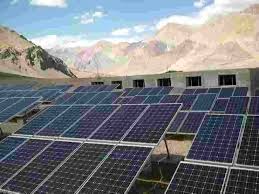Navigating Challenges in Ladakh’s Renewable Energy Transmission Project
Current Affairs NationalPosted by newadmin on 2025-02-12 08:39:30 |
Share: Facebook | Twitter | Whatsapp | Linkedin Visits: 21

The Rs 21,000 crore transmission project in Ladakh is a major initiative aimed at evacuating power from a 13-gigawatt renewable energy park and connecting it to the national grid in Haryana. This ambitious undertaking faces significant challenges, including security concerns due to its proximity to the China border, a shortage of skilled labor, and the need for extensive road infrastructure development. Despite these obstacles, the project holds immense potential for strengthening India’s renewable energy sector, though questions remain about its viability and impact on local communities.
The transmission system will use high-voltage direct current (HVDC) technology to transport electricity over a distance of 480 kilometers. The renewable energy park will primarily generate power from solar and wind sources, contributing significantly to India’s clean energy goals. However, the project's location near an international border necessitates continuous security measures to protect personnel and assets during construction and after completion. Coordination with the armed forces will be essential to mitigate potential threats.
Another major hurdle is the availability of skilled labor. Ladakh has a limited workforce, and the project requires approximately 1,200 skilled workers. To address this, the Power Grid Corporation plans to source labor from other states, which may lead to logistical difficulties and higher project costs. Additionally, the region’s existing transport infrastructure is inadequate for moving heavy equipment to the site. Upgrading roads, bridges, and access routes will be critical, with the Border Roads Organisation assisting in these efforts to ensure the timely delivery of materials.
Financially, the project has received Rs 8,309 crore in grants from the central government, but concerns persist regarding its overall feasibility. High installation costs and the risk of delays add to the uncertainty surrounding its economic viability. The project’s success hinges on the implementation of a planned 12 GWh battery storage system, which is expected to improve capacity utilization and ensure a steady power supply.
Beyond financial and logistical concerns, the project also raises environmental and social issues. Local activists have expressed apprehensions about the ecological impact of the hybrid renewable park, as it may disrupt traditional grazing lands used by nomadic herders. To address these concerns, a pilot solar project has been proposed that would allow livestock grazing beneath solar panels, creating a balance between development and traditional land use.
Construction of the project is set to begin in 2025-26 and will take multiple working seasons to complete. As of late 2024, Ladakh’s renewable energy capacity remains limited, but this project has the potential to transform the region into a major player in India’s renewable energy landscape. If successfully implemented, it could serve as a model for future large-scale renewable energy projects in remote and challenging terrains.
Search
Categories
Recent News
- Bihar's Top Cop Opens Doors to Public Grievances
- Hyderabad Gears Up for Presidential Visit: Traffic Diversions Announced
- Hyderabad Expressway Gridlock: Three-Car Pile-Up Causes Chaos
- Hyderabad Gears Up: Security Measures for Presidential Visit
- Hyderabad's Rs 23 Lakh Scam: Fake Trading App Dupes Investors
- Pinkathon Hyderabad: Empowering Women, One Step at a Time
- Hyderabad's Drug Supply Chain Unravelled
- Hyderabad's New Year's Eve: Safety Meets Celebration
Popular News
- Navigating IPO Market Dynamics Amid Volatility and Regulatory Changes
- Innovative Green Practices and Environmental Initiative
- Massive Worldwide Microsoft Outage Disrupts Multiple Sectors
- తెలుగుదేశం పార్టీ - పేదరికాన్ని నిర్మూలించడంలో వాగ్దానం
- Universities Embrace Remote Learning Technologies Amidst Ongoing Pandemic